Django缓存视图
一、今日学习内容概述
| 学习模块 | 重要程度 | 主要内容 |
|---|---|---|
| 视图缓存基础 | ⭐⭐⭐⭐⭐ | 缓存装饰器、缓存配置 |
| 基于会话缓存 | ⭐⭐⭐⭐⭐ | 会话存储、用户相关缓存 |
| 动态缓存处理 | ⭐⭐⭐⭐ | 条件缓存、缓存失效 |
| 缓存优化策略 | ⭐⭐⭐⭐ | 性能优化、最佳实践 |
二、缓存配置示例
python
# settings.py
CACHES = {
'default': {
'BACKEND': 'django.core.cache.backends.redis.RedisCache',
'LOCATION': 'redis://127.0.0.1:6379/1',
'OPTIONS': {
'CLIENT_CLASS': 'django_redis.client.DefaultClient',
'PARSER_CLASS': 'redis.connection.HiredisParser',
'CONNECTION_POOL_CLASS': 'redis.connection.BlockingConnectionPool',
'CONNECTION_POOL_CLASS_KWARGS': {
'max_connections': 50,
'timeout': 20,
}
}
},
'session': {
'BACKEND': 'django.core.cache.backends.redis.RedisCache',
'LOCATION': 'redis://127.0.0.1:6379/2',
'TIMEOUT': 86400, # 1天
}
}
# 会话引擎配置
SESSION_ENGINE = 'django.contrib.sessions.backends.cache'
SESSION_CACHE_ALIAS = 'session'三、视图缓存实现
3.1 视图装饰器缓存
python
# views.py
from django.views.decorators.cache import cache_page
from django.views.decorators.vary import vary_on_cookie, vary_on_headers
from django.core.cache import cache
from django.shortcuts import render
from .models import Article
# 简单的视图缓存
@cache_page(60 * 15) # 缓存15分钟
def article_list(request):
articles = Article.objects.all()
return render(request, 'blog/article_list.html', {'articles': articles})
# 基于cookie的缓存
@cache_page(60 * 15)
@vary_on_cookie
def user_articles(request):
articles = Article.objects.filter(author=request.user)
return render(request, 'blog/user_articles.html', {'articles': articles})
# 基于请求头的缓存
@cache_page(60 * 15)
@vary_on_headers('User-Agent')
def responsive_view(request):
# 根据User-Agent返回不同的模板
user_agent = request.META.get('HTTP_USER_AGENT', '')
template = 'mobile.html' if 'Mobile' in user_agent else 'desktop.html'
return render(request, template)3.2 高级视图缓存
python
from django.core.cache import cache
from django.conf import settings
from django.utils.cache import get_cache_key
from functools import wraps
import hashlib
def smart_cache_page(timeout=None, cache_key_prefix=None):
def decorator(view_func):
@wraps(view_func)
def wrapper(request, *args, **kwargs):
# 生成缓存键
cache_key = generate_cache_key(request, view_func, args, kwargs)
# 尝试从缓存获取响应
response = cache.get(cache_key)
if response is not None:
return response
# 执行视图函数
response = view_func(request, *args, **kwargs)
# 只缓存成功的响应
if response.status_code == 200:
cache.set(cache_key, response, timeout)
return response
return wrapper
return decorator
def generate_cache_key(request, view_func, args, kwargs):
# 基础键
key_parts = [
view_func.__name__,
request.path,
request.GET.urlencode(),
]
# 如果是认证用户,添加用户ID
if request.user.is_authenticated:
key_parts.append(str(request.user.id))
# 生成hash
key = hashlib.md5(''.join(key_parts).encode()).hexdigest()
return f'view_cache_{key}'
# 使用示例
@smart_cache_page(timeout=300) # 5分钟缓存
def article_detail(request, article_id):
article = Article.objects.get(id=article_id)
return render(request, 'blog/article_detail.html', {'article': article})3.3 基于会话的缓存管理器
python
# cache_managers.py
from django.core.cache import caches
from django.conf import settings
import json
class SessionCacheManager:
def __init__(self, session_key):
self.session_key = session_key
self.cache = caches['session']
def _get_user_cache_key(self, key):
"""生成用户特定的缓存键"""
return f'session_{self.session_key}_{key}'
def get(self, key, default=None):
"""获取缓存数据"""
cache_key = self._get_user_cache_key(key)
value = self.cache.get(cache_key)
return json.loads(value) if value else default
def set(self, key, value, timeout=None):
"""设置缓存数据"""
cache_key = self._get_user_cache_key(key)
self.cache.set(cache_key, json.dumps(value), timeout)
def delete(self, key):
"""删除缓存数据"""
cache_key = self._get_user_cache_key(key)
self.cache.delete(cache_key)
def clear_all(self):
"""清除该会话的所有缓存"""
pattern = f'session_{self.session_key}_*'
self.cache.delete_pattern(pattern)
# 使用中间件自动处理会话缓存
class SessionCacheMiddleware:
def __init__(self, get_response):
self.get_response = get_response
def __call__(self, request):
# 为请求添加缓存管理器
request.cache_manager = SessionCacheManager(request.session.session_key)
response = self.get_response(request)
return response四、缓存流程图

五、实际应用示例
5.1 商品列表缓存
python
# views.py
from django.views.decorators.cache import cache_page
from django.core.cache import cache
from .models import Product
class ProductListView:
def get_products(self, category=None, page=1):
# 生成缓存键
cache_key = f'products_list_{category}_{page}'
products = cache.get(cache_key)
if products is None:
# 查询数据库
queryset = Product.objects.all()
if category:
queryset = queryset.filter(category=category)
# 分页
paginator = Paginator(queryset, 20)
products = paginator.get_page(page)
# 缓存结果
cache.set(cache_key, products, 300) # 5分钟缓存
return products
@cache_page(60 * 5)
def list_view(self, request):
category = request.GET.get('category')
page = request.GET.get('page', 1)
products = self.get_products(category, page)
return render(request, 'shop/product_list.html', {
'products': products
})5.2 用户购物车缓存
python
# cart.py
class CartManager:
def __init__(self, request):
self.session_key = request.session.session_key
self.cache = caches['session']
def get_cart_key(self):
return f'cart_{self.session_key}'
def get_cart(self):
return self.cache.get(self.get_cart_key()) or {}
def add_item(self, product_id, quantity=1):
cart = self.get_cart()
product_id = str(product_id)
if product_id in cart:
cart[product_id]['quantity'] += quantity
else:
cart[product_id] = {
'quantity': quantity,
'added_at': datetime.now().isoformat()
}
self.cache.set(self.get_cart_key(), cart, 86400) # 1天
def remove_item(self, product_id):
cart = self.get_cart()
product_id = str(product_id)
if product_id in cart:
del cart[product_id]
self.cache.set(self.get_cart_key(), cart)
def clear(self):
self.cache.delete(self.get_cart_key())六、性能优化建议
-
缓存键设计
- 使用有意义的前缀
- 避免过长的键名
- 包含版本信息
-
缓存粒度控制
- 合理设置过期时间
- 避免过度缓存
- 考虑缓存成本
-
缓存更新策略
- 主动更新
- 被动失效
- 版本控制
-
缓存监控
- 命中率统计
- 内存使用监控
- 性能分析
七、测试用例
python
# tests.py
from django.test import TestCase, Client
from django.core.cache import cache
from django.urls import reverse
class ViewCacheTests(TestCase):
def setUp(self):
self.client = Client()
cache.clear()
def test_cached_view(self):
# 第一次请求
response1 = self.client.get(reverse('article_list'))
content1 = response1.content
# 修改数据
Article.objects.create(title='Test Article')
# 第二次请求应该返回缓存的内容
response2 = self.client.get(reverse('article_list'))
content2 = response2.content
self.assertEqual(content1, content2)八、常见问题和解决方案
- 缓存穿透
python
def get_data(self, key):
# 使用空值标记
value = cache.get(key)
if value is None:
data = expensive_operation()
if data is None:
# 缓存空值,避免频繁查询
cache.set(key, 'NULL', 300)
else:
cache.set(key, data)
return data
return None if value == 'NULL' else value- 缓存雪崩
python
import random
def set_with_jitter(key, value, timeout):
"""添加随机过期时间,避免同时失效"""
jitter = random.randint(-60, 60)
final_timeout = timeout + jitter
cache.set(key, value, final_timeout)- 缓存一致性
python
def update_data(self, key, value):
"""先更新数据库,再删除缓存"""
try:
# 更新数据库
self.model.objects.filter(pk=key).update(value=value)
# 删除缓存
cache.delete(f'data_{key}')
except Exception as e:
# 记录错误,可能需要后续处理
logger.error(f'Failed to update data: {e}')九、总结
通过本章学习,你应该掌握:
- Django视图缓存的基本使用
- 会话缓存的实现方法
- 缓存性能优化策略
- 常见缓存问题的解决方案
怎么样今天的内容还满意吗?再次感谢朋友们的观看,关注GZH:凡人的AI工具箱,回复666,送您价值199的AI大礼包。最后,祝您早日实现财务自由,还请给个赞,谢谢!